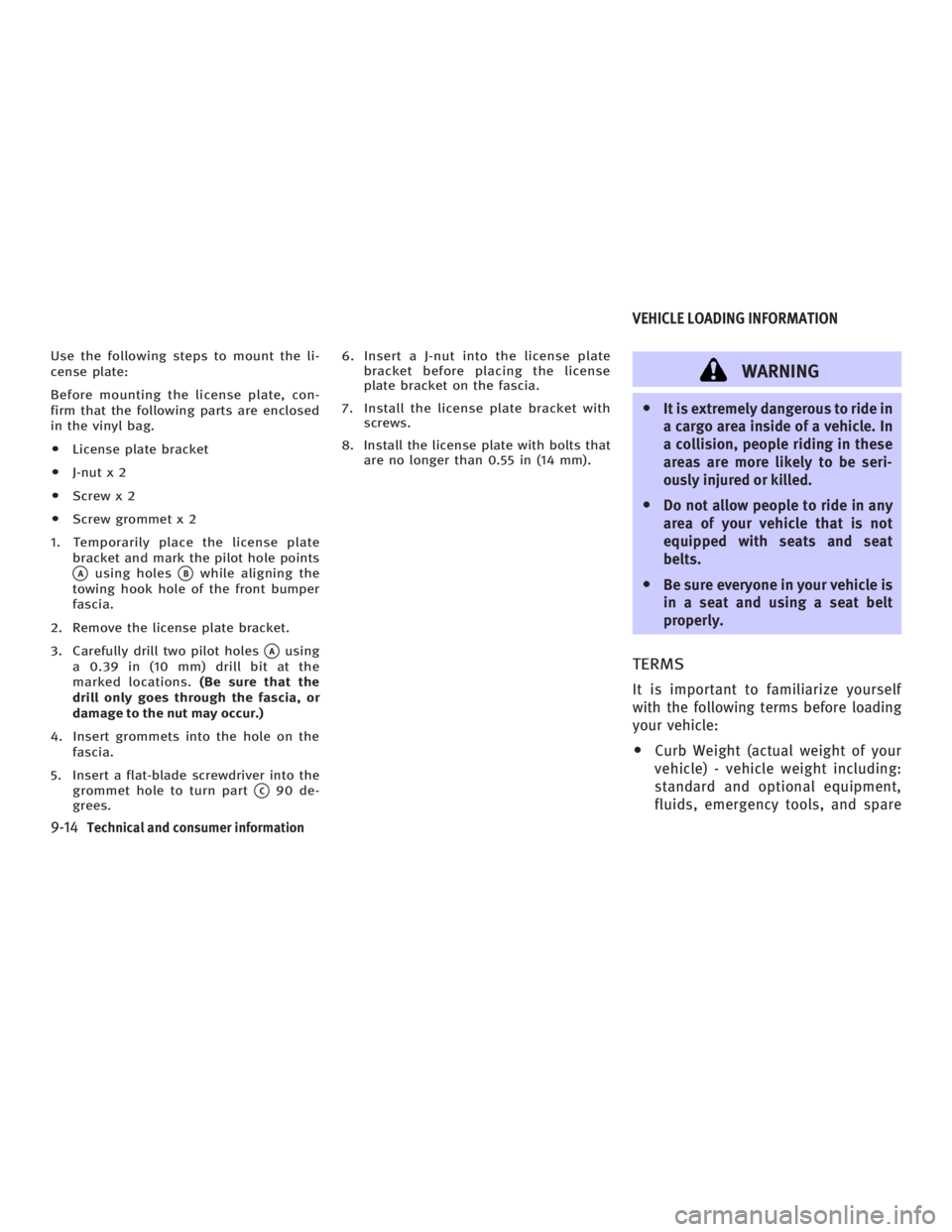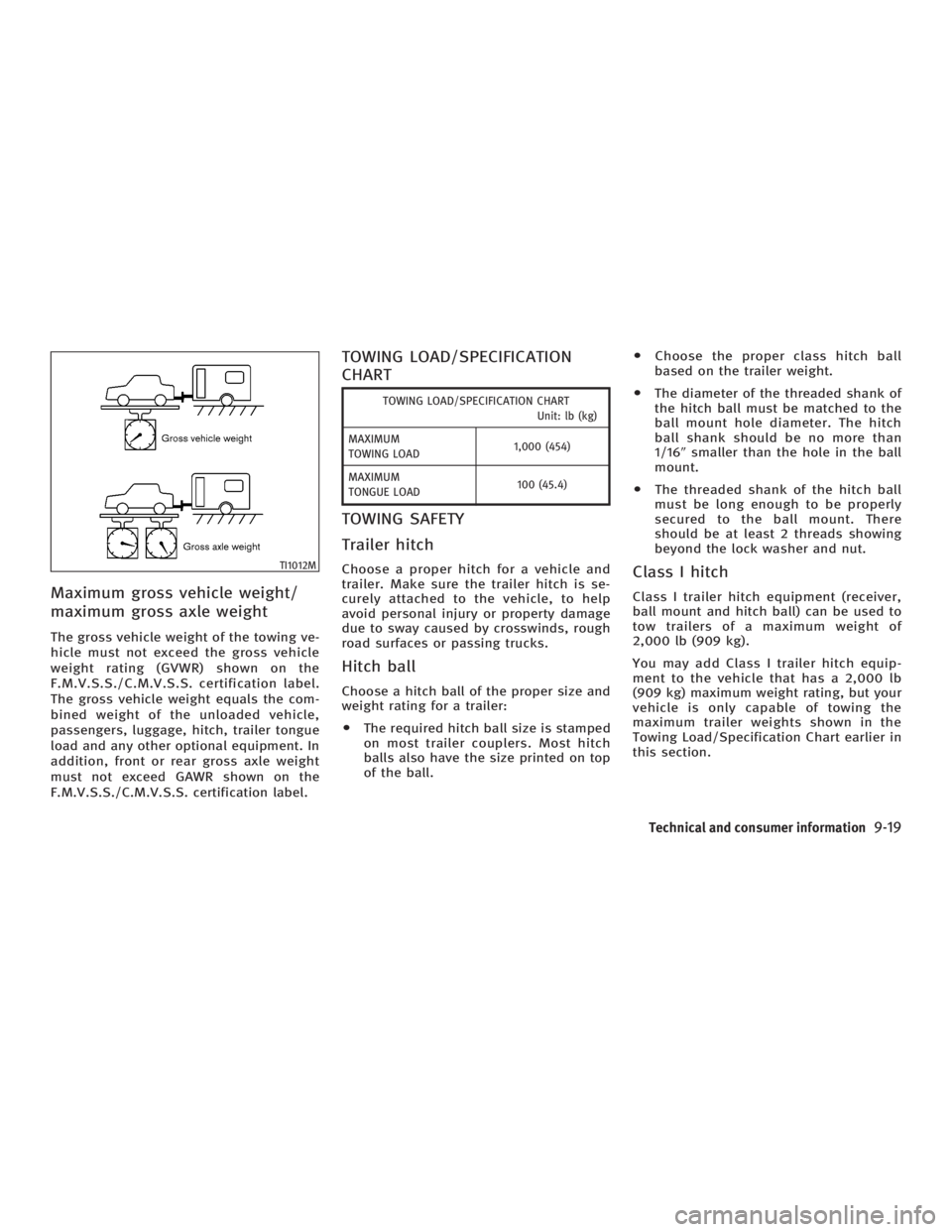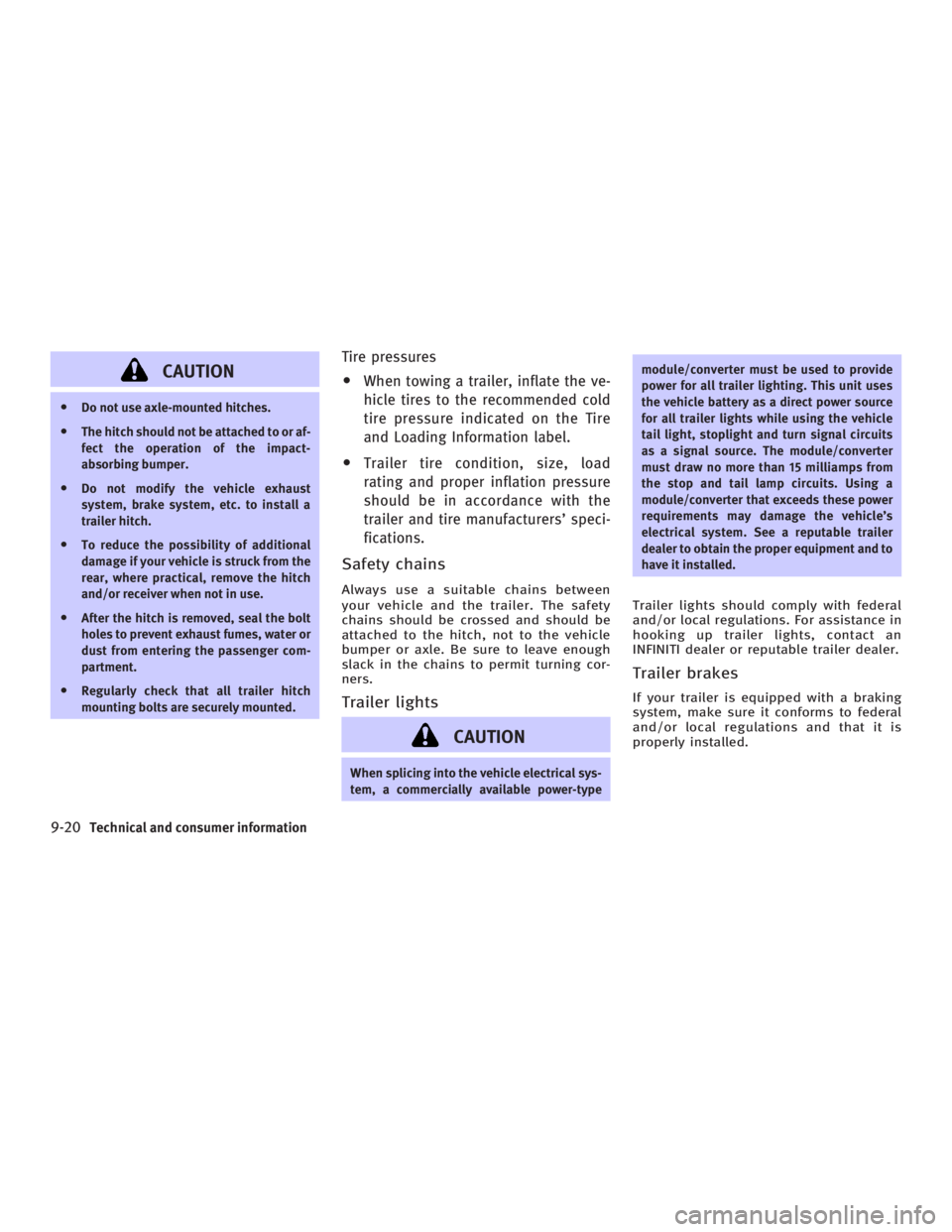2006 INFINITI G35 towing
[x] Cancel search: towingPage 307 of 344

9 Technical and consumer information Capacities and recommended fuel/lubricants ... 9-2
Fuel recommendation .................................. 9-3
Engine oil and oil filter recommendation ..... 9-5
Recommended SAE viscosity number .......... 9-6
Air conditioning system refrigerant and
lubricant recommendations ......................... 9-7
Specifications................................................... 9-8
Engine......................................................... 9-8
Wheels and tires ......................................... 9-9
Dimensions and weights ............................. 9-9
When traveling or registering your vehicle in
another country .............................................. 9-10
Vehicle identification ...................................... 9-10
Vehicle identification number (VIN) plate ... 9-10
Vehicle identification number (Chassis
number) ..................................................... 9-10
Engine serial number ................................. 9-11
F.M.V.S.S./C.M.V.S.S. certification label ..... 9-11
Emission control information label ............. 9-12
Tire and loading information label ............. 9-12
Air conditioner specification label .............. 9-13 Installing front license plate............................ 9-13
Vehicle loading information ............................ 9-14
Terms ........................................................ 9-14
Vehicle load capacity ................................. 9-15
Loading tips ............................................... 9-17
Measurements of weights .......................... 9-17
Towing a trailer ............................................... 9-18
Maximum load limits ................................. 9-18
Towing load/specification chart ................. 9-19
Towing safety ............................................ 9-19
Flat towing ................................................ 9-22
Uniform tire quality grading............................ 9-23
Emission control system warranty .................. 9-24
Reporting safety defects (US only) .................. 9-24
Readiness for inspection/maintenance (I/M)
test (US only).................................................. 9-25
Event data recorders ...................................... 9-26
Owner's Manual/Service Manual order
information ................................................... 9-26
In the event of a collision.......................... 9-27
w 06.1.4/V35-D/V5.0
X
Page 312 of 344

Selecting the correct oil filter Your new vehicle is equipped with a high-
quality genuine NISSAN oil filter. When re-
placing, use the genuine oil filter or its
equivalent for the reason described in
change intervals.
Change intervals The oil and oil filter change intervals for
your engine are based on the use of the
specified quality oils and filters. Oil and
filter other than the specified quality, or
oil and filter change intervals longer than
recommended could reduce engine life.
Damage to engines caused by improper
maintenance or use of incorrect oil and
filter quality and/or viscosity is not cov-
ered by the new INFINITI vehicle limited
warranties.
Your engine was filled with a high quality
engine oil when it was built. You do not
have to change the oil before the first rec-
ommended change interval. Oil and filter
change intervals depend upon how you
use your vehicle. Operation under the fol-
lowing conditions may require more fre-
quent oil and filter changes.
O repeated short distance driving at cold
outside temperatures O driving in dusty conditions
O extensive idling
O towing a trailer
O stop and go commuting
Refer to the ªINFINITI Service and Mainte-
nance Guideº for the maintenance sched-
ule.
RECOMMENDED SAE VISCOSITY
NUMBER
SAE 5W-30 viscosity oil is preferred for all
ambient temperatures. SAE 10W-30,
10W-40 viscosity oil may be used if the am-
bient temperature is above 0ÉF (þ18ÉC). TI1028-C
9-6 Technical and consumer information
w 06.1.4/V35-D/V5.0
X
Page 320 of 344

Use the following steps to mount the li-
cense plate:
Before mounting the license plate, con-
firm that the following parts are enclosed
in the vinyl bag.
O License plate bracket
O J-nut x 2
O Screw x 2
O Screw grommet x 2
1. Temporarily place the license plate
bracket and mark the pilot hole points
q A
using holes
q B
while aligning the
towing hook hole of the front bumper
fascia.
2. Remove the license plate bracket.
3. Carefully drill two pilot holes
q A
using
a 0.39 in (10 mm) drill bit at the
marked locations. (Be sure that the
drill only goes through the fascia, or
damage to the nut may occur.)
4. Insert grommets into the hole on the
fascia.
5. Insert a flat-blade screwdriver into the
grommet hole to turn part
q C
90 de-
grees. 6. Insert a J-nut into the license plate
bracket before placing the license
plate bracket on the fascia.
7. Install the license plate bracket with
screws.
8. Install the license plate with bolts that
are no longer than 0.55 in (14 mm).
WARNING O It is extremely dangerous to ride in
a cargo area inside of a vehicle. In
a collision, people riding in these
areas are more likely to be seri-
ously injured or killed.
O Do not allow people to ride in any
area of your vehicle that is not
equipped with seats and seat
belts.
O Be sure everyone in your vehicle is
in a seat and using a seat belt
properly.
TERMS It is important to familiarize yourself
with the following terms before loading
your vehicle:
O Curb Weight (actual weight of your
vehicle) - vehicle weight including:
standard and optional equipment,
fluids, emergency tools, and spare VEHICLE LOADING INFORMATION
9-14 Technical and consumer information
w 06.1.4/V35-D/V5.0
X
Page 323 of 344

the vehicle. That weight may not
safely exceed the available cargo
and luggage load capacity calcu-
lated in Step 4.
6. If your vehicle will be towing a
trailer, load from your trailer will be
transferred to your vehicle. Consult
this manual to determine how this
reduces the available cargo and lug-
gage load capacity of your vehicle.
Before driving a loaded vehicle, confirm
that you do not exceed the Gross Ve-
hicle Weight Rating (GVWR) or the
Gross Axle Weight Rating (GAWR) for
your vehicle. See ``Measurement of
Weights'' later in this section.
Also check tires for proper inflation
pressures. See the Tire and Loading In-
formation label.
LOADING TIPS
O The GVW must not exceed GVWR or
GAWR as specified on the F.M.V.S.S./C.M.V.S.S. certification
label.
O Do not load the front and rear axle
to the GAWR. Doing so will exceed
the GVWR.
WARNINGO Properly secure all cargo with
ropes or straps to help prevent it
from sliding or shifting. Do not
place cargo higher than the seat-
backs. In a sudden stop or colli-
sion, unsecured cargo could cause
personal injury.
O Do not load your vehicle any
heavier than the GVWR or the
maximum front and rear GAWRs. If
you do, parts of your vehicle can
break, tire damage could occur, or
it can change the way your vehicle
handles. This could result in loss
of control and cause personal
injury. O Overloading not only can shorten
the life of your vehicle and the tire,
but can also cause unsafe vehicle
handling and longer braking dis-
tances. This may cause a prema-
ture tire failure which could result
in a serious accident and personal
injury. Failures caused by over-
loading are not covered by the ve-
hicle's warranty.
MEASUREMENT OF WEIGHTS
Secure loose items to prevent weight
shifts that could affect the balance of
your vehicle. When the vehicle is
loaded, drive to a scale and weigh the
front and the rear wheels separately to
determine axle loads. Individual axle
loads should not exceed either of the
gross axle weight ratings (GAWR). The
total of the axle loads should not ex-
ceed the gross vehicle weight rating
(GVWR). These ratings are given on the
vehicle certification label. If weight rat-
ings are exceeded, move or remove
items to bring all weights below the rat-
ings. Technical and consumer information
9-17
w 06.1.4/V35-D/V5.0
X
Page 324 of 344

WARNINGOverloading or improper loading of a trailer
and its cargo can adversely affect vehicle
handling, braking and performance and may
lead to accidents.
CAUTIONO Do not tow a trailer or haul a heavy load
for the first 500 miles (800 km). Your engine, axle or other parts could be
damaged.
O For the first 500 miles (800 km) that you
tow a trailer, do not drive over 50 mph
(80 km/h) and do not make starts at full
throttle. This helps the engine and other
parts of your vehicle wear in at the
heavier loads.
Your new vehicle was designed to be
used primarily to carry passengers and
cargo. Remember that towing a trailer will
place additional loads on a vehicle's en-
gine, drive train, steering, braking and
other systems.
An INFINITI Towing Guide (U.S. only) is
available on the website at
www. infiniti.com. This guide includes in-
formation on trailer towing capability and
the special equipment required for proper
towing.
MAXIMUM LOAD LIMITS
Maximum trailer loads Never allow the total trailer load to ex-
ceed the value specified in the Towing
Load/Specification Chart found later in this section. The total trailer load equals
trailer weight plus its cargo weight.
Towing loads greater than specified or us-
ing improper towing equipment could ad-
versely affect vehicle handling, braking
and performance. The ability of a vehicle
to tow a trailer is not only related to the
maximum trailer loads, but also the
places you plan to tow. Tow weights ap-
propriate for level highway driving may
have to be reduced on very steep grades
or in low traction situations (for example,
on slippery boat ramps).
CAUTION Vehicle damage resulting from improper
towing procedures are not covered by
INFINITI warranties.
Tongue load Keep the tongue load between 9 and 11%
of the total trailer load within the
maximum tongue load limits shown in the
following Towing Load/Specification
Chart. If the tongue load becomes exces-
sive, rearrange cargo to allow for proper
tongue load.TI1011M
TOWING A TRAILER
9-18 Technical and consumer information
w 06.1.5/V35-D/V5.0
X
Page 325 of 344

Maximum gross vehicle weight/
maximum gross axle weight The gross vehicle weight of the towing ve-
hicle must not exceed the gross vehicle
weight rating (GVWR) shown on the
F.M.V.S.S./C.M.V.S.S. certification label.
The gross vehicle weight equals the com-
bined weight of the unloaded vehicle,
passengers, luggage, hitch, trailer tongue
load and any other optional equipment. In
addition, front or rear gross axle weight
must not exceed GAWR shown on the
F.M.V.S.S./C.M.V.S.S. certification label. TOWING LOAD/SPECIFICATION
CHART TOWING LOAD/SPECIFICATION CHART
Unit: lb (kg)
MAXIMUM
TOWING LOAD 1,000 (454)
MAXIMUM
TONGUE LOAD 100 (45.4)
TOWING SAFETY
Trailer hitch Choose a proper hitch for a vehicle and
trailer. Make sure the trailer hitch is se-
curely attached to the vehicle, to help
avoid personal injury or property damage
due to sway caused by crosswinds, rough
road surfaces or passing trucks.
Hitch ball Choose a hitch ball of the proper size and
weight rating for a trailer:
O The required hitch ball size is stamped
on most trailer couplers. Most hitch
balls also have the size printed on top
of the ball. O Choose the proper class hitch ball
based on the trailer weight.
O The diameter of the threaded shank of
the hitch ball must be matched to the
ball mount hole diameter. The hitch
ball shank should be no more than
1/16 0 smaller than the hole in the ball
mount.
O The threaded shank of the hitch ball
must be long enough to be properly
secured to the ball mount. There
should be at least 2 threads showing
beyond the lock washer and nut.
Class I hitch Class I trailer hitch equipment (receiver,
ball mount and hitch ball) can be used to
tow trailers of a maximum weight of
2,000 lb (909 kg).
You may add Class I trailer hitch equip-
ment to the vehicle that has a 2,000 lb
(909 kg) maximum weight rating, but your
vehicle is only capable of towing the
maximum trailer weights shown in the
Towing Load/Specification Chart earlier in
this section.TI1012M
Technical and consumer information
9-19
w 06.1.4/V35-D/V5.0
X
Page 326 of 344

CAUTIONO Do not use axle-mounted hitches.
O The hitch should not be attached to or af-
fect the operation of the impact-
absorbing bumper.
O Do not modify the vehicle exhaust
system, brake system, etc. to install a
trailer hitch.
O To reduce the possibility of additional
damage if your vehicle is struck from the
rear, where practical, remove the hitch
and/or receiver when not in use.
O After the hitch is removed, seal the bolt
holes to prevent exhaust fumes, water or
dust from entering the passenger com-
partment.
O Regularly check that all trailer hitch
mounting bolts are securely mounted. Tire pressures
O When towing a trailer, inflate the ve-
hicle tires to the recommended cold
tire pressure indicated on the Tire
and Loading Information label.
O Trailer tire condition, size, load
rating and proper inflation pressure
should be in accordance with the
trailer and tire manufacturers' speci-
fications.
Safety chains Always use a suitable chains between
your vehicle and the trailer. The safety
chains should be crossed and should be
attached to the hitch, not to the vehicle
bumper or axle. Be sure to leave enough
slack in the chains to permit turning cor-
ners.
Trailer lights
CAUTION When splicing into the vehicle electrical sys-
tem, a commercially available power-type module/converter must be used to provide
power for all trailer lighting. This unit uses
the vehicle battery as a direct power source
for all trailer lights while using the vehicle
tail light, stoplight and turn signal circuits
as a signal source. The module/converter
must draw no more than 15 milliamps from
the stop and tail lamp circuits. Using a
module/converter that exceeds these power
requirements may damage the vehicle's
electrical system. See a reputable trailer
dealer to obtain the proper equipment and to
have it installed.
Trailer lights should comply with federal
and/or local regulations. For assistance in
hooking up trailer lights, contact an
INFINITI dealer or reputable trailer dealer.
Trailer brakes If your trailer is equipped with a braking
system, make sure it conforms to federal
and/or local regulations and that it is
properly installed.
9-20 Technical and consumer information
w 06.1.4/V35-D/V5.0
X
Page 327 of 344

WARNINGNever connect a trailer brake system directly
to the vehicle brake system.
Pre-towing tips O Be certain your vehicle maintains a
level position when a loaded and/or
unloaded trailer is hitched. Do not
drive the vehicle if it has an abnormal
nose-up or nose-down condition;
check for improper tongue load, over-
load, worn suspension or other pos-
sible causes of either condition.
O Always secure items in the trailer to
prevent load shifts while driving.
O Load the trailer so approximately 60%
of the trailer load is in the front half
and 40% is in the back half.
O Check your hitch, trailer tire pressure,
vehicle tire pressure, trailer light op-
eration, and trailer wheel lug nuts
every time you attach a trailer to the
vehicle.
O Be certain your rear view mirrors con-
form to all federal, state or local regula- tions. If not, install any mirrors required
for towing before driving the vehicle.
Trailer towing tips In order to gain skill and an under-
standing of the vehicle's behavior, you
should practice turning, stopping and
backing up in an area which is free from
traffic. Steering stability, and braking per-
formance will be somewhat different than
under normal driving conditions.
O Always secure items in the trailer to
prevent load shift while driving.
O Avoid abrupt starts, acceleration or
stops.
O Avoid sharp turns or lane changes.
O Always drive your vehicle at a mod-
erate speed. Some states or provinces
have specific speed limits for vehicles
that are towing trailers. Obey the local
speed limits.
O When backing up, hold the bottom of
the steering wheel with one hand.
Move your hand in the direction in
which you want the trailer to go. Make
small corrections and back up slowly.
If possible, have someone guide you
when you are backing up. O Always block the wheels on both vehicle
and trailer when parking. Parking on a
slope is not recommended; however, if
you must do so, and if your vehicle is
equipped with automatic transmission,
first apply the parking brake and block
the wheels, and then move the transmis-
sion selector lever into the P (Park) posi-
tion. If you move the selector lever to
the P (Park) position before applying the
parking brake and blocking the wheels,
transmission damage could occur.
O When going down a hill, shift into a
lower gear and use the engine braking
effect. When going up a long grade,
downshift the transmission to a lower
gear and reduce speed to reduce
chances of engine overloading and/or
overheating.
However, for long steep grades, do
not stay in 1st or 2nd gear when
driving above 35 MPH (56 km/h).
O If the engine coolant rises to an ex-
tremely high temperature when the air
conditioning system is on, turn off the
air conditioner. Coolant heat can be
additionally vented by opening the
windows, switching the fan control to
high and setting the temperature con-
trol to the HOT position.
Technical and consumer information
9-21
w 06.1.4/V35-D/V5.0
X